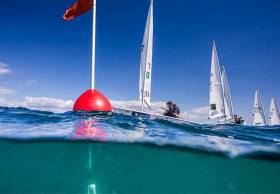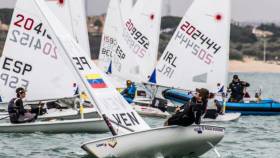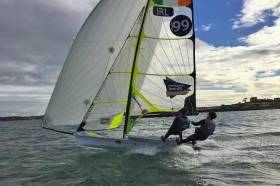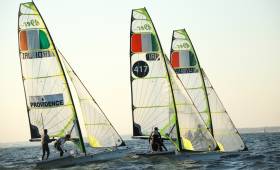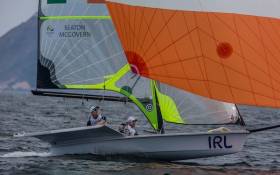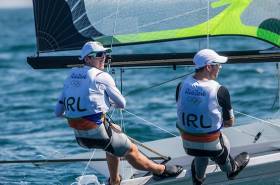Displaying items by tag: 49er
Seaton & Guilfoyle Are Top of Six Irish 49ers at Kiel Week
After a breezy edition of 2017 Kiel Week, it was Belfast's Ryan Seaton and Cork's Seafra Guilfoyle who were top of the six Irish campaigns that travelled to Kiel Week in Germany last week. The London and Rio helmsman with new Royal Cork crew Guilfoyle were 18th in a 69–boat fleet dominated by the heavy air speed of the Australians.
Seaton concluded he was pleased to 'mix it up at the front of the gold fleet in some races'.
Also sailing in the gold fleet were Robert Dickson and Sean Waddilove were next in 26th with Cian Byrne and Patrick Crosbie two places behind in 30th.
Mark Hassett and Oisin O'Driscoll were 32nd in silver fleet with Sean and Tadgh Donnelly 38th. Matt McGovern and Robbie Gilmore completed the Irish sixsome in 40th.
Next up for the Irish crews will be training camps in Denmark, before heading back to Kiel for the 49er Europeans.
After some stand–out performances in the qualifying rounds of the Trofeo Princesa Sofía in Mallorca this week, Belfast Laser sailor Liam Glynn sailed in the first day of the ultra competitive Gold fleet yesterday. The former Topper World Champion has graduated to the Laser full rig having finished 29th in the Laser Radial Boys World Championships at the Royal St. George YC in Dun Laoghaire last year. He is currently 45th from 60 in gold with more races for the entire 134–boat Laser fleet today.
Equal levels of top consistency proved elusive across the two races for the Laser class, particularly among the top three sailors who all sailed one bogey result today. Spain’s emerging Grand Canaria based Joel Rodriguez is back at the top of the fleet.
The Royal Irish YC sailor Saskia Tidey from Dun Laoghaire who is now sailing with Team GB's Charlotte Dobson lies fifth in the 49erFX.
A silver fleet finish for all four Irish 49ers in Palma, Mallorca this week is a reminder of the competitiveness of the Olympic sailing circuit and the standard required to secure the single Irish berth for Tokyo in 2020. Results are here.
In the Finn class, Donaghdee's Oisin McClleland is 31st from 57.
Four Irish 49ers Seek Perfect Olympic Campaign Start in Palma
Four of five of Ireland's full–time 49er Olympic campaigns launch this morning at the showcase Trofeo Princesa Sofía Regatta in Palma, Mallorca.
Northern Ireland helmsman Ryan Seaton, tenth in Rio, won the class in Palma last year but sails this time with new crew Seafra Guilfoyle. The North–South duo will be looking for a repeat performance in their Goldfinger named boat to get their Tokyo 2020 campaign off to a perfect start.
Wet Dreams sailed by Mark Hassett and Oisin O'Driscoll from West Cork, Seán and Tadhg Donnelly from the National Yacht Club as well as Howth's Robert Dickson and Sean Waddilove (recovered from injury) are also in action, all setting out on the first stages of what they hope will be a successful journey to the 2020 Olympic regatta in Tokyo, Japan. But only one will qualify.
The Olympic sailing competition of the 48 Trofeo Princesa Sofia IBEROSTAR will see almost 700 boats and 900 sailors from 56 nations race across the ten Olympic classes in the bay of Palma, in Majorca, Spain, from Monday 27 March to Saturday 1 April.
The 49er sailors are joined in Palma by two Belfast single-handers. Former Topper World Champion Liam Glynn and Donaghdee's Oisin McClelland will race in the Laser and Finn classes respectively.
There is also Irish interest in the women's 49erfx where the Royal Irish Yacht Club's Saskia Tidey competes for Team GB with Charlotte Dobson.
Seaton's London and Rio partner, Matt McGovern, who is now teamed up with Strangford's Robbie Gilmore, is not travelling to Palma, concentrating instead on the Delta Lloyd regatta in Holland in May. From there McGovern and Gilmore head to Kiel Week in June. In July the 49er Europeans are also in Kiel. The final event of our European season will be the 49er Worlds in Porto in August.
In any event, there will be no shortage of competition in the 49er for the four Irish boats with Argentina’s young pairing of Yago and Klaus Lange finished seventh in Rio and were fifth in Miami at the Sailing World Cup also attending. Poland’s Lukasz Przybytek and Pawel Kolodzinski were eighth in Rio and seventh in the 49er Europeans last year in Barcelona. And the Spanish pair of Diego Botin and Lago Lopez Marra were third in Miami, third in the 2016 Europeans and third in Palma last year and ninth in the Olympic regatta in Rio. In Miami in January Brasilian legend five times Olympic medallist Robert Scheidt opened a new chapter in his storied career with 16th at his first regatta in the 49er class with crew Gabriel Borges. They will be looking to prove their progression here. GBR’s 2004 Olympic bronze medallist Simon Hiscocks races with young Daniel Budden. Compatriots Dylan Fletcher and Alan Sign, sixth in Rio, start here after winning Miami.
There are changes to the format of the race in Palma. For example the 49er and 49er FX Classes will now be decided over three ten minute races over an Arena Style rectangle course.
The 49er fleet race in two groups Monday and Tuesday and then Wednesday and Friday are Semi Finals for 25 boats. From these aggregate scores there are ten boats advancing to a three race Medal Race Final.
Ferran Muniesa Manager of the Trofeo Princesa Sofía explains:
“ It was immediately obvious from last November’s World Sailing General Meeting that Olympic sailing needs changes to the format which was used in Rio 2016, as pushed for by the International Olympic Committee, by the Olympic classes and by the sailors themselves, recognising that Final day needs to be more understandable. At the last Olympics there were several cases where medals were already won before the Medal Race and that does not make sense to those who maybe do not know sailing, nor does it make for an exciting finale.
So we agreed with the Events Committee to get in touch with all of the different classes and to look at their proposals. Thus all off these formats come from the classes themselves. There is no point in experimenting without the backing of the classes. Now we hope we have formats which are more understandable to non experts.”
He adds:
“ We are a regatta which likes to innovate and to rise to a challenge like this. We have had a lot to adapt, not least the result systems. In practical terms that also means another course area on the last day and more people to run it. It’s a great challenge for the Trofeo Princesa Sofía IBEROSTAR. At first when we went through the proposals our people were looking at me like ‘what on earth?’…Now here we are ready to do it all. This is the right time to do it. We can be a little more flexible at this time in the quadrennial but you have to test it on a big scale like this, at a good level.
Irish 49er Teams (x5) Prepare for Palma Regatta, Laser Radial Sailors Look for Andalusian Winds
The Andalusian Olympic Sailing Week venue at Cadiz might have been a favourite with some of Europe's top Laser Radial sailing talent this week but it has not proved such a big hit in the wind stakes so far.
300 sailors and 50 coaches from 23 countries, among them Olympic medalists, and world champions have been sailing in Andalusia including eight Irish Radial sailors and ten Irish 49er sailors but its been a poor show for the wind with only two races completed after 'a long, long, long, long day' waiting for breeze on Sunday, according to one of the Irish entrants, Howth Yacht Club's Aoife Hopkins.
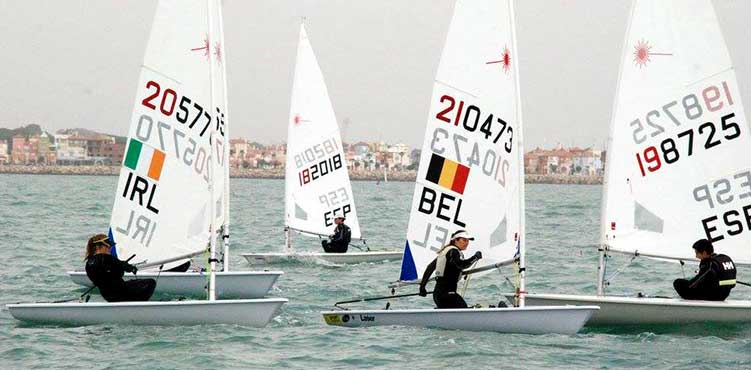 Howth's Aoife Hopkins (205770) chases Evi Van Acker of Belgium (210473) the 2012 Olympic Bronze Medalist, in Cadiz this week
Howth's Aoife Hopkins (205770) chases Evi Van Acker of Belgium (210473) the 2012 Olympic Bronze Medalist, in Cadiz this week
It has been weak on the water for the Radials but it has proved equally frustrating ashore for other Olympic classes where organisers cancelled racing in the 49er, 49er fx, 470 m / w and 420 due to lack of entries.
49er Winter Training Camp
Since last December, Ireland's five 49er teams have been treating Cadiz as a Winter training base and continue to train there til Wednesday. The ten sailors will get their first taste of international battle in Spanish waters early next month when they relocate to the the much–hyped Palma de Mallorca regatta.
'It never gets easier, you just get better' declare Dun Laoghaire's Donnelly brothers, Tadhg and Sean, having completed an intense Winter period perfecting boat handling manoeuvres in the high speed skiff. Their last session in Cadiz was an intense 11–day affair. They're heading home now to the National Yacht Club for a well–earned week off before traveling out to Mallorca for their first regatta of their 2020 campaign.
The crews are under the watchful eye of Tytus Konarzewsk who is one of Europe’s most respected 49er sailing coaches.
Next stop Palma de Mallorca will be an important Irish 49er marker because the Donnelly's will be up against Irish rivals Ryan Seaton and Seafra Guilfoyle, Matt McGovern and Robbie Gilmore, Mark Hassett and Oisin O’Driscoll as well as Robert Dickson and Sean Waddilove who will – hopefully – all be in action at the first mens skiff test towards Tokyo 2020.
But before Howth Yacht Club's Dickson and Waddilove hit the water again, they also face a race back to fitness after a calf injury sustained in Cadiz by crew Waddilove who found out just how tough Olympic sailing can be, 49er style.
The accident happened last Wednesday, the first day back training at the February Training Camp. Waddilove explains: 'It was quite windy that day, up to 25 knots at times and I think we must have decided to bear away at one of these times. We almost had the boat flat downwind, almost ready to run in and hoist when a gust hit and we were flung back upwind and capsized to leeward. First protocol when this happens is to jump clear of the boat or climb down onto the dagger board if you can. However the force was so strong Rob ended up going through the main sail and I went to jump off the wing to windward but the force made it hard to jump far enough away from the boat so I ended up hitting my leg off the dagger board on the way down'.
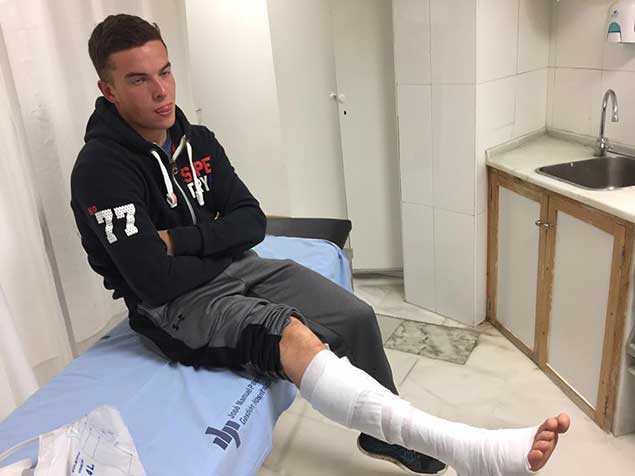 Sean Waddilove injury: 'My leg feels ok at the moment so I have been back training after a few light cycles, upper body gym sessions and a lot of icing, elevating and compression bandaging' Photo ISA/Facebook
Sean Waddilove injury: 'My leg feels ok at the moment so I have been back training after a few light cycles, upper body gym sessions and a lot of icing, elevating and compression bandaging' Photo ISA/Facebook
All the Irish 49er teams are claiming to have made 'really big improvements' over the past few months so there should be plenty of Irish mens skiff competition to come in March and the rest of the 2017 season.
Meanwhile, in the mens and womens Laser radial fleet, some well known names are finding the going tough in fickle Spanish breezes including 2012 Olympic bronze medalist Evi Van Acker of Belgium who is 17th on the mixed gender 114–boat scoresheet. (Downloadable results below). Ireland best results to date are Royal Cork's Johnny Durcan in 48th and Lough Derg's Aisling Keller 63rd.
London and Rio Olympic 49er crew Matt McGovern is moving to the position of helmsman in a new campaign for Tokyo 2020. Ballyholme Yacht Club (BYC) say the Belfast Lough star, who split from sailing partner Ryan Seaton at the end of last season, will now sail with former top Northern Ireland youth sailing performer Robbie Gilmore.
It's yet another skiff team for Ireland that could now see as many as four campaigns contest the single Tokyo slot. Afloat.ie reported earlier on the burgeoning Irish 49er scene here.
Carrickfergus Sailing Club's Seaton, also sailing with another top Irish youth sailor, Cork Harbour's Seafra Guilfoyle, has already declared that a Gold Medal in Tokyo is the target for their new north–south campaign. Seaton and Guilfoyle intend to make Mallorca this Spring their first event and have launched a crowdfunding campaign to raise the €5k to get them there.
Meanwhile, McGovern, who has swapped his crew position for the helm in the 49er and teamed up with the 2013 ISA Youth Champion Robbie Gilmore of Strangford Lough Yacht Club, is working hard, hitting the water six days a week to get the new NI campaign up to international speed.
Irish 49er Duo Launch Crowdfunding Campaign For Tokyo 2020 Ambitions
#49er - More than €5,000 is the cost of competition for Ryan Seaton and Seafra Guilfoyle as they prep for their first event as a duo in Mallorca this coming spring.
The new combination have joined with PledgeSports to crowdfund the necessary budget for a new 49er skiff plus flights, accommodation and ferries as they ready for their debut competition event in the Balearic Islands.
Ahead of that, they will be training with other Olympic hopeful teams and coaches in Cadiz and Mallorca in preparation for a season that builds on a tremendously successful 2016 for Irish high performance sailing.
As previously reported on Afloat.ie, last month double Olympian Seaton teamed up with 20-year-old Royal Cork prospect Guilfoyle, making his comeback from an injury that ruled him out of last summer’s Olympics, with ambitions to represent Ireland in the skiff class at Tokyo 2020.
But they will face strong competition for that spot, not least from Seaton’s former partner and fellow Belfast sailor Matt McGovern, with whom he finished in the top 10 in Rio, who is also currently looking for a new skiff partner.
More on the €5,350 Seaton and Guilfoyle are looking to raise can be found on the PledgeSports website HERE.
Royal Cork's Seafra Guilfoyle Joins Ryan Seaton for Tokyo Olympic Campaign
Royal Cork dinghy sailor Seafra Guilfoyle (20) will team up with Belfast double Olympian Ryan Seaton for a Tokyo 2020 Olympic 49er campaign.
The move brings the curtain down on an eight year campaign by Seaton who split from crew Matt McGovern after Rio. Seaton had been trialling a number of crew replacements since Rio, as earlier reported by Afloat.ie.
McGovern, also from Belfast, is in talks to find a new sailing partner as he intends to continue for Tokyo too.
According to Royal Cork Yacht Club, Seaton and Guilfoyle will make a formal announcement of the campaign in Crosshaven this Friday. The duo will be looking to build on the Rio top ten finish.
Guilfoyle, an ISAF youth silver medalist in the Laser Radial from 2014, withdrew from the 2016 Mens Laser trial with a back injury.
As Afloat.ie reported in Ireland may field as many as four Olympic 49er campaigns for Tokyo. Read our 49er profile here.
Irish 49ers Are Ahead of the Curve
Is it a bird, is it a plane? The International 49er Skiff is twenty years old in 2016, and it has been part of the Olympics since 2000. Yet for most sailors it is still as modern and bewildering as the day after tomorrow. W M Nixon tries to make sense of a class which finds itself in a good place in Ireland at the moment.
It doesn’t do to think too hard about the slim 16ft 49er skiff. Almost immediately you’ll jump to the conclusion that it’s actually a trimaran which is still awaiting the fitting of its floats. And then, when you see them zooming along at full speed with all three sails pulling in perfect unison and the crew of two exactly horizontal and cool as you please on their trapezes, you can’t help but think that it’s all too good to be true, for what they’re doing is equivalent to balancing – indeed ballet dancing - on the head of a pin, and the slightest error will lead to a sudden and almighty mess.
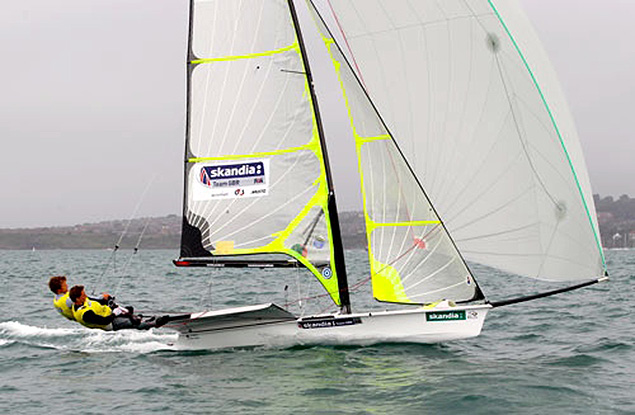 The 49er ideal – perfect balance, minimal spray, maximum speed
The 49er ideal – perfect balance, minimal spray, maximum speed
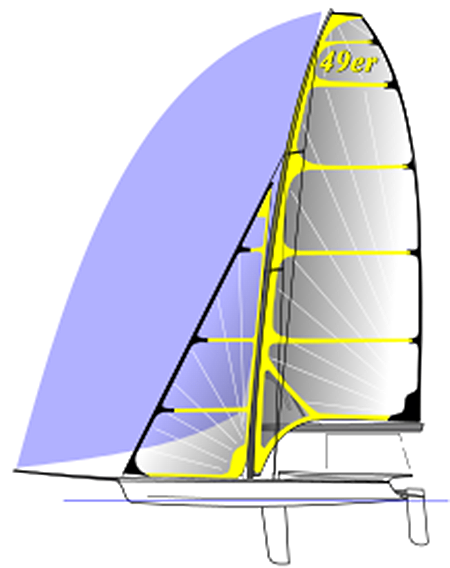 The 49er still looks more modern than the day after tomorrow
The 49er still looks more modern than the day after tomorrow
In thinking that, you’d be absolutely right. When everything is in the right place and functioning smoothly, the 49er is an impressive sailing machine. But when she goes head over heels or whatever you want to call it (the word “capsize” is much too tame), everything seems to get fouled up with everything else, and unravelling it all can take for ever.
There’s one particular trick of the 49er which sums up the challenge of sailing these very special Olympic boats. The hulls are just slips of things, with only the minimum of buoyancy needed to get them up to speed, and then as the speed confers extra buoyancy, you’re in business. But in that crucial moment as you break out the assymetric in a proper breeze before working speed develops, you might just see the bow dipping a little, then the nose goes that tiny bit under water, and things go from bad to worse in an instant. You’re going down the mine. And a very deep mine it can be too.
So you might wonder why the 49er is ringing a bell in Ireland at the moment. It’s clearly a specialist interest, and there’s no denying that those who can make a good fist of sailing it are an elite. Furthermore, it really only makes real sense when seen as an Olympic class, which makes it about as different as possible from the trusty old Laser at the bottom of the garden, the only boat to succeed in being an Olympic class while continuing to be universally popular with a huge variety of users at the same time.
Thus the 49er and its adherents are in a sort of parallel universe which only actively intersects in three ways with the rest of us. The main one is when the buildup to the Olympics and the Olympics themselves are topping the headlines, and the other two are when there’s a major global championship involving the 49er, possibly at a nearby venue, while the third is when the special group of 49er trainees under the ISA Performance Scheme are in Ireland on one off their fortnight-long training camps, as is happening at the moment at the National Yacht Club in Dun Laoghaire.
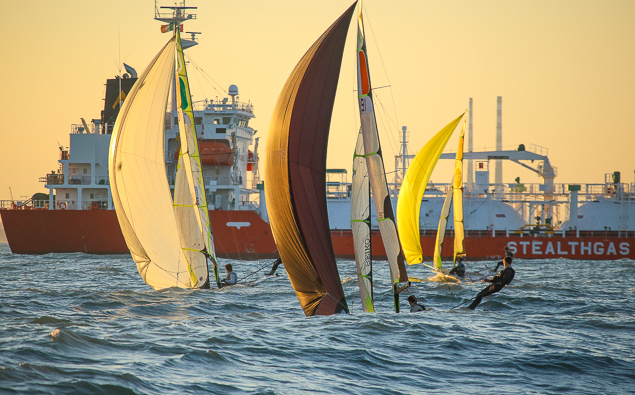 Ireland’s core 49er Training Squad in action in Dublin Bay this week – in foreground are Sean and Tadgh Donnelly, beyond are Robert Dickson and Sean Waddilove, and Oisin O’Driscoll and Mark Hassett. Photo: Afloat.ie
Ireland’s core 49er Training Squad in action in Dublin Bay this week – in foreground are Sean and Tadgh Donnelly, beyond are Robert Dickson and Sean Waddilove, and Oisin O’Driscoll and Mark Hassett. Photo: Afloat.ie
 A word with the coach – Schull’s Oisin O’Driscoll and Mark Hassett with Tytus Konarzewski. Photo: Afloat.ie
A word with the coach – Schull’s Oisin O’Driscoll and Mark Hassett with Tytus Konarzewski. Photo: Afloat.ie
It’s unusual, as many of the training camps have tended in recent years to be based during our winter at Cadiz in southern Spain. But don’t go along to the National YC this weekend expecting to see an array of 49ers. For a start, training sessions are a rather private affair. But as it is, we’re talking specialist numbers in dedicated highly-trained small groups, and to best understand that, a quick canter through the history of the 49er helps.
The modern skiff emerged from the legendary Sydney Harbour 18 footers which raced for impressive money prizes on that wonderful stretch of city-surrounded water, the racing closely followed by big harbour ferries crowded out with spectators betting like crazy on the results. In the early days, the quest for speed was met by crowding on ever more sail and somehow fitting aboard ever more crewmen to hang out as best they could – sometimes on each others shoulders – to keep the whole show on the road. And if they happened to capsize in a harbour whose waters might include a man-eating shark or two, not to worry – by this stage the sail areas had become so enormous it was reckoned the vast spread of white cloth on the surface of the sea would frighten away even the hungriest shark.
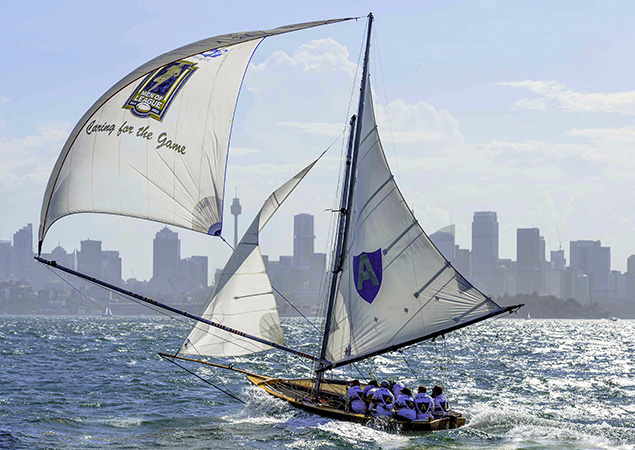 When power and weight mattered – a well-crewed Sydney Harbour 18-footer in all her glory. As designers learned that less is more, the leaner skiff concept emerged.
When power and weight mattered – a well-crewed Sydney Harbour 18-footer in all her glory. As designers learned that less is more, the leaner skiff concept emerged.
The rest of the world had just become used to these mad Sydney sailors using colossal sail area and moveable human ballast to achieve speed when the Aussies with innovative geniuses like Frank Bethwaite started to go the other way. The boats were still 18ft long. But with trampoline-like wings either side and a smaller crew hung out on trapezes, better speeds could be obtained with much less fuss. The Sydney Harbour 18ft skiff was re-defined, and with the 2000 Olympics scheduled for Sydney, the idea that a modern purpose-developed skiff would make an ideal Olympic sailing boat gained traction.
Or at least that’s how it all looks in hindsight. Doubtless there are as many narrative versions of how it all really came about as there were skiff types which showed up for an official Olympic Skiff selection trial on Lake Garda in 1996. What we do know is that the 49er skiff, designed by Julian Bethwaite of Australia and built by Dave Ovington in the northeast of England, emerged head and shoulders above everything else. And unlike a much earlier time when selection trials for a three man Olympic keelboat somehow saw the Soling being selected despite the fact that the Etchells 22 was clearly the better boat, this time righteousness prevailed, and the 49er made her Olympic debut just four years later.
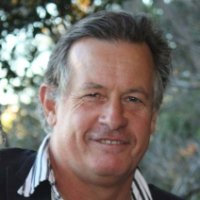 Julian Bethwaite, designer of the 49er
Julian Bethwaite, designer of the 49er
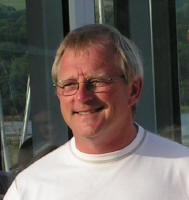
That in itself was something of a miracle of productivity, as the 49er has settled down with just two main builders worldwide, Ovington in England and MacKay in New Zealand.
That things were a bit hectic with larger-than-life characters in the early days goes without saying, and Irish sailing kept intersecting with it in a tangential way. Thus Gerry Donleavy of Dun Laoghaire, whose notable sailing CV incudes the British & Irish Flying Fifteen titles, found himself in 1990 at the FF Worlds in Brisbane, Australia, and among the boats he was racing against was one crewed by Dave Ovington from Newcastle in the northeast of England. Dave was a noted builder of Flying Fifteens (for which Gerry was Irish agent) and other racing machines, with Ovington’s career given an early rocket-assisted start when he built an all-conquering Enterprise dinghy for a rising talent called Lawrie Smith.
There was a layday during those 1990 Brisbane FF Worlds, and the competitors were taken off on a river cruise which included watching the local skiffs racing. Ovington was completely hooked by the whole skiff concept. He soon linked up with the formidable brains of the Bethwaite family to work towards production, but as Julian Bethwaite – son of the legendary Frank - is a perfectionist and endless experimenter all in one, it reputedly took at least five years of trialling and testing before he was satisfied with what eventually became the aft end of the new 49er.
Nevertheless the new machine was ready enough for Lake Garda in 1996, and the rest is history. But so too alas is Dave Ovington. The production rate for his surprisingly small “factory” in North Shields on Tyneside close east of Newcastle was already prodigious, with a selection of superb racing craft, yet he and the other builders managed to meet most of the demand for 49ers for the 2000 Olympics, and things were in running order for the 2004 Games as well.
But the pace was literally killing. In 2005, while getting ready to go out for a family sail on Lake Windermere, Dave Ovington dropped dead with a heart attack. He was only fifty. His sudden departure brought home a realisation of all that he had done in creating a world focus of top quality racing boat building in the unlikely setting of Tyneside, using dedicated local labour – only around fifteen in all - which he trained to be among the most talented boat-makers in the world, despite the fact that many of them don’t sail.
Dave Ovington left quite a legacy, and the continuing success of Ovington Boats is tangible evidence of it, with the company run by a dedicated triumvirate of three executives. Gerry Donleavy says he never fails to be impressed by the good working atmosphere in a plant producing top-level boats on which an entire nation’s Olympic hopes will rest, and it’s the reassuring structure on which the 49er Class is based which has led to the ISA Performance Director James O’Callaghan making such a strong commitment to the class.
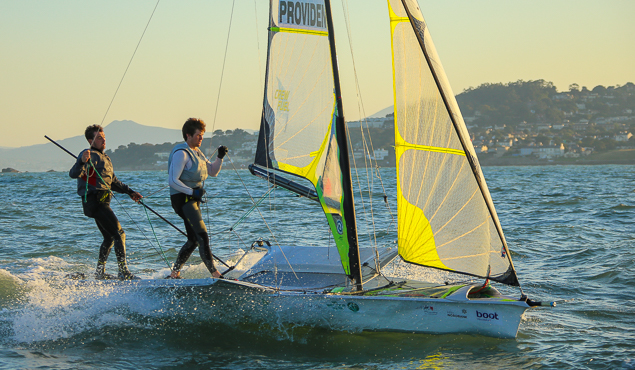 A long way from Schull. Mark Hassett and Oisin O’Driscoll in this week’s Dublin Bay 49er Training Camp. Photo: Afloat.ie
A long way from Schull. Mark Hassett and Oisin O’Driscoll in this week’s Dublin Bay 49er Training Camp. Photo: Afloat.ie
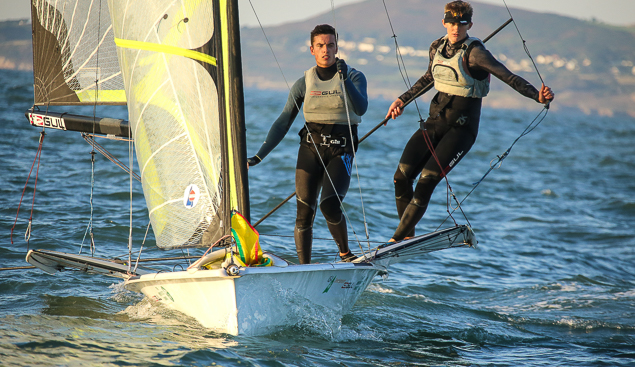 Sean Waddilove and Rob Dickson make up one of the ISA’s three core 49er crews. Photo: Afloat.ie
Sean Waddilove and Rob Dickson make up one of the ISA’s three core 49er crews. Photo: Afloat.ie
“We have to operate on a tight budget” says O’Callaghan, “and the 49er offers great value. It’s absolutely standardised, you just buy the boats and the parts and the sails off the shelf, and you know it’s a level playing field after that. With some other non-single-handed Olympic classes, there’s too much choice, too many builders involved. But with the 49er, the unknowns are taken out of the equation, and you can get on with planning and implementing a training programme relatively untroubled by boat issues”
In keeping it that way, the 49er Class worldwide has benefitted from Irish experience in running sailing organisations. Marcus Spillane (42) hails from Cork and a Crosshaven sailing background, but this past week he has been putting the final details into place in his new base in San Francisco after several gloriously busy years at the top end of some very exciting business ventures in New York. It’s said of running your own business that if you’re not having fun or making a lot of money, then why are you doing it? But Marcus Spillane seems to manage to do both, and he fits in quite a bit of sailing while he’s at it, having got involved with the Laser 2s in UCC both as sailor and then longer term as an administrator, through which he met Laser 2 designer Frank Bethwaite (who unlike Dave Ovington, lived to a lively 92) and his son Julian.
 Marcus Spillane, President of the International 49er Class, has this week been confirmed as President of the International NACRA 17 Class.Spillane’s other sailing has included Fastnets and Round Irelands and a lot of Etchells 22s and other racing in America (he’ll be doing the Caribbean 600 next February in a Swan 66), but as well he somehow found the time to include the 49er, and has great memories of fun championships with the congenial ISA coach Rory Fitzpatrick as crew.
Marcus Spillane, President of the International 49er Class, has this week been confirmed as President of the International NACRA 17 Class.Spillane’s other sailing has included Fastnets and Round Irelands and a lot of Etchells 22s and other racing in America (he’ll be doing the Caribbean 600 next February in a Swan 66), but as well he somehow found the time to include the 49er, and has great memories of fun championships with the congenial ISA coach Rory Fitzpatrick as crew.
Yet even a couple of minutes of talking with Marcus Spillane will reveal that he has more useful ideas about how sailing generally and its specialist sectors can be properly run than a whole committee room full of blazers. So naturally he was soon drafted into the admin side of the 49er on a voluntary basis, he then became the class’s World CEO in addition to his multiple other activities in business and sport, and in 2012 he was elected President of the International 49er Association with colleague Ben Remocker of Canada as Class Manager.
By this time the 49ers had gone through a re-vamp to improve the value and boat appeal which James O’Callaghan – who had been appointed ISA Performance Director in 2006 – rates so highly. While the basic concept remained the same, it was agreed that there had been so many advances in sails, spars and rigs in sailing generally that in order to reinforce the 49er’s image as being cutting edge, the rig should be up-graded and the one design nature of the hull should be put beyond all question.
This was done in 2009, resulting in the 49er we see today, based on a hull from master-moulds made only by MacKay, but producing boats in the Northern Hemisphere with Ovington, and in the Southern with MacKay, under a production programme so tightly controlled that you could argue the modern 49er is the world’s first true one design.
Of course it’s still a minority interest as a boat to sail, even if what happens in the class afloat and in the training camps is increasingly a matter of pubic interest. At a major championship in North America they might expect to see 80 boats, if it’s a major international championship held in Europe (where the class’s ancestral home of Lake Garda is a popular venue) you can expect 120 boats.
Yet so much is at stake among those 120 boats in international terms that the efficient running of the class worldwide is vitally important, and for the past four years the Spillane/Remocker duo have been making such a good job of running the International 49er Association that as of Wednesday night this week they have also taken on the running of the new Olympic class, the 2011-designed NACRA 17 Catamaran, which with its mixed-gender two person crew made a successful debut at Rio, but found itself with a class administration no longer able to cope with demand.
That the NACRA 17’s future was placed in Marcus Spillane’s hands will tell you something of how highly the 49er Class Association president from Ireland is rated in the administration of international sailing, and he also finds time to represent Ireland at the top – he’ll be very effectively working the rooms on behalf of many interests at the World Sailing conference next month in Barcelona.
He does all this with such good humour and enthusiasm that it made learning more about the 49er a very entertaining chat rather than an earnest journalistic endeavour, so now we have some idea about what those guys are sailing as they buzz about Dublin Bay this weekend.
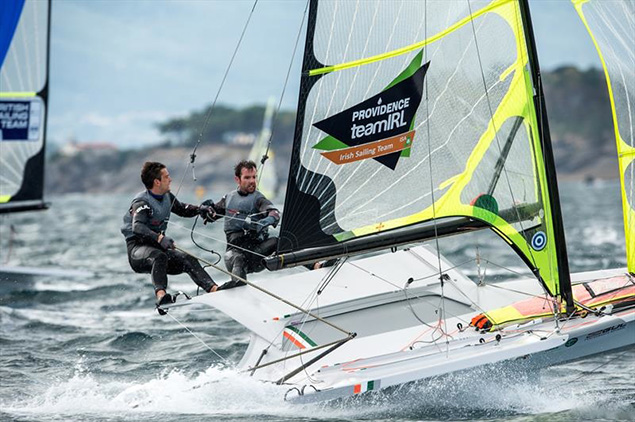 Ryan Seaton and Matt McGovern in action. Following the 2016 Olympics, they will now provide the 49er Class with two crews, as McGovern has teamed up with a new sailing partner, and Seaton is currently testing three different potential crewmates.
Ryan Seaton and Matt McGovern in action. Following the 2016 Olympics, they will now provide the 49er Class with two crews, as McGovern has teamed up with a new sailing partner, and Seaton is currently testing three different potential crewmates.
For some years now, the 49er in Ireland was all about Ryan Seaton and Matt McGovern from Belfast Lough, whose often lone pursuit of training competition and international championships was quietly heroic in itself, for with a different spin of the dice they might have been on the podium in 2012. Then they hit world headlines in 2016 by winning gold in Palma in April, and in Rio in August they had two race wins and were definitely contenders.
Also very much in the public eye were Andrea Brewster and Saskia Tidey of the RIYC in Dun Laoghaire, who made it into an Olympic 49er FX place at the last chance in February 2016, and then had the energies of top coach Tytus Konarzewski given over to them virtually full time in the buildup to Rio. The result was a more-than-respectable performance, and in all the intense Irish involvement in Olympic 49er campaigning was well justified.
This fitted very neatly with The Plan. It’s given all sorts of official titles, and reams of reports could be written about it, but basically since about 2014 James O’Callaghan has had three very promising young 49er crews in training, and they came on so well that by the end of 2014 they’d got to a stage he hadn’t expected to reach until early 2016, such that this week – albeit in a low key way – he is introducing a complete squad which will raise 49er sailing in Ireland, and for Ireland, to a new level.
This is in the knowledge that Matt McGovern has parted the ways with Ryan Seaton to set up a new 49er equipe with another crewmate, while Seaton is keen to stay in the game and he has three potential new partners in mind, though whether he’ll be testing any of them in the current programme in Dun Laoghaire remains to be seen.
Then there are the Nippers, Doug Elmes of Kilkenny and Colin O’Sullivan of Malahaide, the competent kids who took bronze in the 420 Youth Worlds in Malaysia at New Year, won the 420 Irish Opens during the summer going away, and then at the end of August suddenly appeared at their sailing base of Howth with their newly-acquired 49er, having leapt clean over any ideas of a 29ers or a 470 on the way.
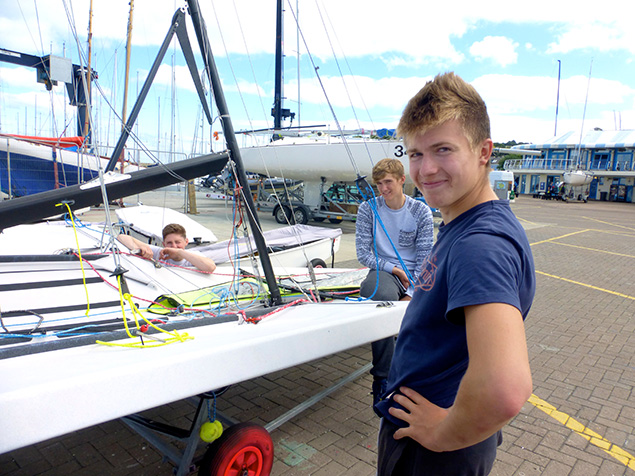
As for the 29ers, breeding ground for future 49er champs, the two Harrys – Durcan and Whittaker of Royal Cork – may be Ireland’s only active representatives, but they made a great job of it by winning the British Championship 2016, and now their sights are set on the 29er Worlds next year in California, but after that a 49er is surely the logical step.
Of course we’ve had waves of 49er interest in Ireland before – when it was new around 2000-2002, the class surged to maybe seven boats. What we’re looking at now is a comparable number, but there a depth to it that’s encouraging, and the three favoured young crews have been performing beyond expectation to provide a core for potential success well into the Olympic future.
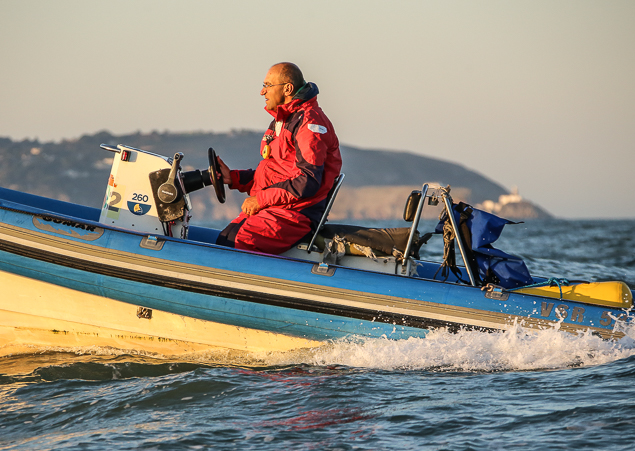 The Main Man. Tytus Konarzewski is one of Europe’s most respected sailing coaches, and the Irish 49er training squad have the use of his services until the end of 2016. Photo: Afloat.ie
The Main Man. Tytus Konarzewski is one of Europe’s most respected sailing coaches, and the Irish 49er training squad have the use of his services until the end of 2016. Photo: Afloat.ie
Thanks to the ISA’s Development and Youth Academies and Performance Pathways, and the quiet behind-the-scenes work by the Irish Sailing Foundation to add resources to funds coming from Sports Ireland, the work can go on. And although Tytus Konarzewski’s special talents were almost wholly devoted to coaching Andrea Brewster and Saskia Tidey in the six-month buildup to the Olympics, his contract runs to the end of 2016, and he’s now fulltime with the 49er crews, and there’ll be two more two-week training camps before the end of the year, both in Cadiz with one in November and the other in December.
 Making the best of light breezes and lumpy seas in Dublin Bay. Rob Dickson and Sean Waddilove, with the Donnelly brothers beyond. Photo: Afloat.ie
Making the best of light breezes and lumpy seas in Dublin Bay. Rob Dickson and Sean Waddilove, with the Donnelly brothers beyond. Photo: Afloat.ie
The three crews marked for destiny are Oisin O’Driscoll from Schull and Mark Hassett from Baltimore, Sean and Tadgh Donnelly from Dun Laoghaire, and Robert Dickson from Howth with Sean Waddilove from Skerries. In this year of all years, Irish sailors have some idea of just how much is involved in a campaign towards the Olympics. We wish them well, these young people and their supports teams.
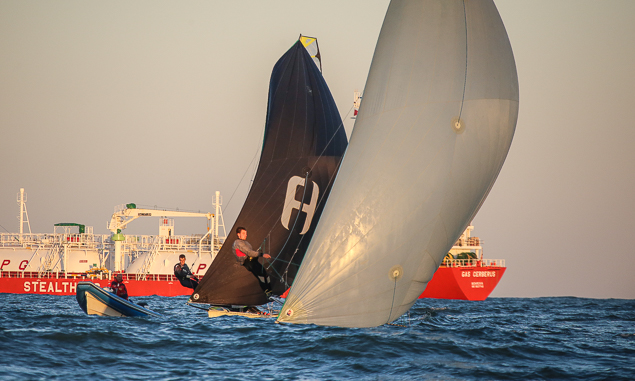 They say the truest good work is done by stealth, but we never thought to see it as clearcut as this…….The 49ers head into the sunset after making the most of an October evening. Their current training camp on Dublin Bay continues to the end of next week, and then training is resumed with another two week camp in Cadiz in November. Photo: Afloat.ie
They say the truest good work is done by stealth, but we never thought to see it as clearcut as this…….The 49ers head into the sunset after making the most of an October evening. Their current training camp on Dublin Bay continues to the end of next week, and then training is resumed with another two week camp in Cadiz in November. Photo: Afloat.ie
Tenth Overall for Seaton & McGovern at 2016 49er Olympic Regatta
Ryan Seaton and Matt McGovern entered the medal race in the Men's 49er today, knowing that medals were out of their reach, but they were looking to cap a fine performance in the preliminary stages with a good medal race result. The New Zealander pairing had been already declared winners before the ultimate race had started, so the fight was for the minor placings. Statistically, only the 4th place Brits could improve into a medal position, leaving 5th to 10th positions to battle it out for bragging rights.
The New Zealand team, with no pressure on them sailed straight into the lead, and, as so often in the past, did not relinquish it until the finish to crown a great series, a great quad and to win the gold in considerable style.
Behind them the Irish gamble on the left side on the 2nd beat didn’t pay off but a British capsize at the bottom mark and some smart sailing up the beat, followed by a gybe set at the final windward mark saw the Irish boat recover to 6th, only to lose three places in the final approach to the finish.
So a 10th overall for Seaton and McGovern, a wonderful result that sets them up for the next four years. They will take great confidence forward, particularly with a series that included two 1sts a 2nd and a 4th.
Ryan Seaton & Matt McGovern Compete in 49er Medal Race To Seal Best Olympic Performance
Northern Ireland's Ryan Seaton and Matt McGovern gave themselves a great medal race boost by winning the final race of their qualification series in the 49er class on Tuesday. It was their second race win of the 12–race series. The Ballyholme Yacht Club pair are eighth overall on 103 points, some 33–points off the bronze medal position for today's race. Double points are at stake in today's medal race at 5pm (Irish time).
The best the Northern Irish pair can do is fifth overall as there are 33 points between themselves and third with only 20 points available. There are 23 points between fourth and eighth, but only 11 between fifth and eighth. The best possible result is to finish six places ahead of DEN, four ahead of FRA and three ahead of ARG.
In a week of high's for Irish sailing, their inclusion in today's climax is another major success for Irish Olympic sailing because – quite apart from Annalise's Olympic Silver medal performance and her fourth at London 2012 – if they can hold on to eighth it will be Ireland's only top eight finish overall since 1980. Seaton and McGovern finished 14th overall at their first Olympics in London four years ago having been in medal contention at the half way stage in Weymouth.
Overall, this means Rio represents Ireland's best ever Sailing Olympics by a long chalk.
Today, in the 49er class, Peter Burling and Blair Tuke (NZL) have already won the gold medal, and did it with two races to spare after dominating the 20-boat fleet at Rio 2016 over the past week. The New Zealanders have gone undefeated in major competition in the 49er fleet since taking the silver medal at London 2012. They have won all four of the last World Championships and were expected to deliver gold for New Zealand this week. Even Burling and Tuke might be surprised at the ease with which they've managed their extraordinary feat, however.
Behind them the battle rages on for the other medals, with Erik Heil and Thomas Ploessel (GER) holding second place in front of the 2012 Olympic Champions Nathan Outteridge and Iain Jensen (AUS).




























